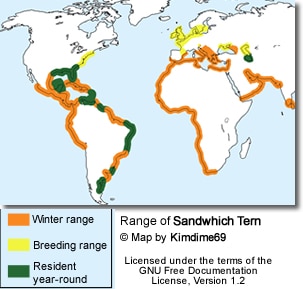Red-legged Honeycreepers
The Red-legged Honeycreepers (Cyanerpes cyaneus) – also known as Blue Honeycreepers – are small songbirds commonly found in tropical Central and northern South America from Mexico south to Brazil.
Their common names are derived from the breeding male’s blue plumage and bright red legs and feet. They are also popular in America’s pet and cage bird trade.
Distribution / Habitat
These Honeycreepers are distributed from southeast Mexico – from Veracruz and Puebla to the south, through Oaxaca and Chiapas; to the east across the Yucatan Peninsula. From there, they range south through Panama into South America, specifically Colombia from where their ranges stretches east to Ecuador, Peru and Bolivia; and west to Venezuela and central Brazil.
They are also found on the islands of Trinidad and Tobago, and Cuba – where they may have been introduced.
These resident / non-migratory birds are mostly associated with forest edges, in shrubs, fields, coffee, cocoa or citrus plantations, parks and clearings with scattered trees – from sea level to about 5,000 feet (~1500 meters) asl.
They typically remain in the canopy and mid-story and live in small groups of up to 15 or 20 individuals.
Subspecies and Ranges:
- Red-legged Honeycreeper (nominate) (Cyanerpes cyaneus cyaneus – Linnaeus, 1766)
- Range: Tropical southeastern Venezuela to the Guianas and northwestern Brazil south to the Negro River and the mouth of the Amazon River. Also found on Trinidad.
- Red-legged Honeycreeper (ssp. carneipes) (Cyanerpes cyaneus carneipes – Sclater, PL, 1860)
- Range: Gulf slope of southeastern Mexico to northwestern Colombia; Coiba and Pearl Islands.
- Red-legged Honeycreeper (ssp. gemmeus) (Cyanerpes cyaneus gemmeus – Wetmore, 1941)
- Range: Northern Colombia in Serranía de Macuire on the Guajira Peninsula)
- Red-legged Honeycreeper (ssp. ssp. pacificus) (Cyanerpes cyaneus pacificus – Chapman, 1915)
- Range: Pacific coast of western Colombia, south from Baudó Mountains, and western Ecuador – south to Pichincha.
- Red-legged Honeycreeper (ssp. gigas) (Cyanerpes cyaneus gigas – Thayer & Bangs, 1905)
- Range: Gorgona Islands (off Pacific coast of western Colombia)
- Red-legged Honeycreeper (ssp. eximius) (Cyanerpes cyaneus eximius – Cabanis, 1850)
- Range: Northern Colombia – from the Santa Marta region, Sierra de Perijá and western slope of the eastern Andes in Santander – to western and northern Venezuela, from western Zulia, the base of both slopes of Andes, mountains of northern Falcón and Yaracuy, and coastal cordillera from Carabobo east to Sucre. Also found on Isla Margarita (Margarita Island).
- Red-legged Honeycreeper (ssp. dispar) (Cyanerpes cyaneus dispar – Zimmer, JT, 1942)
- Range: Eastern Colombia (from Meta and Negro– Guainía river region) east of Andes) to southern Venezuela (Amazonas), western Brazil – east to the Negro and Juruá rivers – and northeastern Peru – south to Yarinacocha. They are rare in eastern Ecuador.
- Red-legged Honeycreeper (ssp. tobagensis) (Cyanerpes cyaneus tobagensis – Hellmayr & Seilern, 1914)
- Range: Tobago Island
- Red-legged Honeycreeper (ssp. brevipes) (Cyanerpes cyaneus brevipes – Cabanis, 1850)
- Range: Central Amazonian Brazil, in the middle and lower Amazon River region, from Manacapurú east to middle Tocantins river .
- Red-legged Honeycreeper (ssp. holti) (Cyanerpes cyaneus holti – Parkes, 1977)
- Range: Coastal eastern Brazil – from Alagoas south to Rio de Janeiro
- Red-legged Honeycreeper (ssp. violaceus) (Cyanerpes cyaneus violaceus – Zimmer, JT, 1942)
- Range: South-eastern Peru, central and northern Bolivia and western Brazil (east to Mato Grosso)
Description
Size
- Largest of the Cyanerpes honeycreepers
- Length (including tail): 4.7 – 5.12 inches (~ 12 – 13 cm)
- Average Weight: 0.5 oz or 14 g
- Note: The Tobagian subspecies, Cyanerpes cyaneus tobagensis , is slightly larger than birds found on the mainland.
Plumage Details / Adults
- Breeding Male: Violet blue plumage with a turquoise cap, velvety black eye mask, mantle, wings, and tail; and brilliant blue wing patches.
- Non-breeding Male: Resembles the female, with dull olive-green plumage and black wings
- Females and Juveniles: Plumage is dull green above and pale yellow with faint greenish streaks below.
- Both genders have lemon yellow underwing coverts/feathers that are only visible in flight
Other Physical Details
- Legs: Bright red in males; a duller red-brown in females and brown in juveniles.
- Bill: Medium-long, slender, black, slightly decurved
Similar Species
- Can easily be distinguished from the related male Shining Honeycreeper (Cyanerpes lucidus) its yellow legs and black throat. It also lacks the turquoise cap and yellow underwing feathers.
Diet / Feeding
They feed primarily on tiny insects, and some fruit (such as small berries and fleshy arils) as well as nectar that is extracted from various flowers, in particular Inga, Calliandra, Flame trees (Erythrina spp.) and Huito or Jagua (Genipa americana). They will also eat a variety of seeds with pulp.
Breeding / Nesting
Female Red-legged Honeycreepers are responsible for building small cup nests typically in trees. A typical clutch consists of 2 – 3 eggs that hatch after 12 to 14 days of incubation – a task solely performed by females. The chicks fledge when they are 14 to 15 days old.
Red-legged Honeycreepers generally produce only one clutch a season.
Calls / Vocalizations / Sounds / Recordings
Their calls are described as thin, high-pitched tsip, sharp tsui; or low nasal chaa; and their songs as deliberate and prolonged tsip-tsip-chaa-tsip-tsip-tsic-cha.
Alternate (Global) Names
Chinese: ????? … Czech: Kvetomil modrý … Danish: Rødbenet Honningsuger … Dutch: Blauwe Suikervogel … German: Türkisnaschvogel … Estonian: punajalg-türkiistangara … Finnish: Isomesitangara … French: Guit-guit saï, Sucrier à jambes rouges … Hungarian: kék cize … Italian: Cianerpe zamperosse, Mielero zamperosse … Japanese: rurimitsudori … Norwegian: Rødbeinhonningkryper … Polish: blekitniczek czerwononogi, Sai bladog?owy … Portuguese: Sai-beija-flor … Russian: ????????? ?????????? … Slovak: medosavka tyrkysová … Spanish: Aparecido de San Diego, Mielerito Patirrojo / Pata Roja, Tucuso Monatñés … Swedish: Turkosfågel



